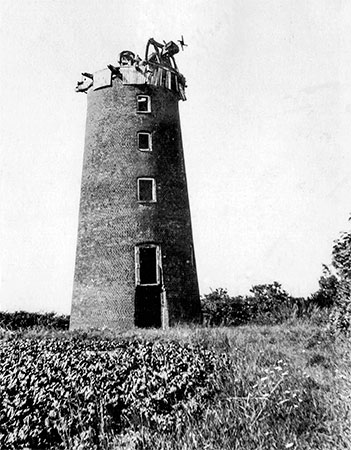
|
Hindringham
Lower Green towermill |
 |
30th July 1937 |
|
Hindringham Lower Green tower mill was a 5 storey red brick mill that was located to the north of the village along with a farm. It was built c.1844 to replace a postmill on the same site. |
The 5 storey towermill was built of Norfolk red brick with a Norfolk boat shaped cap holding a 6 bladed fan and a gallery. The 4 double shuttered sails each had 8 bays of 3 shutters and powered 3 pairs of stones, the largest of which was 5 feet in diameter. Other machinery included a flour mill and a sifter. By 1862 a bakehouse had been installed and was operating from the site along with a Garwood 10hp steam engine for auxliiary power after the mill had been badly damaged in a gale. The above photo shows that the inner stocks have weakened and have started to bend. |
THE LATE HURRICANE |
HINDRINGHAM... The tower windmill in the occupation of Mr. Williams sustained considerable damage. The flyers were blown off and the wind soon became tail to wind , when in a few minutes every sail was blown into shreds, a field being strewn with fragments, some being blown to a considerable distance and large iron torn and twisted into all shapes and forms. Norfolk News - 10th March 1860 |
To Let With Immediate Possession |
A FARM containing 80 acres of ARABLE AND PASTURE LAND together with a Tower Windmill having five floors, three pairs of stones, flour mill and sifter, a Bake office, Dwelling house, 2 Cottages, Farm buildings, and Granaries complete, situated in the parish of Hindringham, (a good corn district) distant from railway station three miles and about six miles from the ports of Wells and Blakeney and the market town of Fakenham, Norfolk. Apply to Wm. Cooke, Glandford, Blakeney. Norfolk Chronicle - 22nd November 1862 |
| Local Bankrupts (From LONDON GAZETTE) Friday November 21 William Williams, Hindringham, Nfk. Miller Norfolk Chronicle - 29th November 1862 |
HINDRINGHAM |
William Williamson's farming stock, a Garwood 10h.p. portable steam engine and mill utensils were sold by auction on 9th December 1862. |
Court of Bankruptcy, London, December 9 (Before Mr. Registrar Higgins) Re: WILLIAM WILLIAMS This was the first sitting for proof of debts and choice of assignees under the bankruptcy of William Williams of Hendringham in this county, miller, farmer, and dealer in agricultural manures. Messrs. Hayes, Tursden & Co. of Russell Square appeared as solicitors for the petitioning creditors, the Messrs. Gurney. The 'trading' of the bankrupt for two years past was proved by Mr. Samuel Nicholson of Fakenham, chemist and druggist and the 'act of bankruptcy' was founded on a declaration of insolvency executed by the bankrupt on the 7th of last month. Mr. Commissioner Goulburn made the adjudication on the 15th November and the bankrupt having surrendered, was granted protection from arrest. Several proofs of debts were tendered and admitted at this sitting and the creditors nominated Mr. John Butler of Barney, a farmer to be the assignee and hew accepted the office. The bankrupt applied for an allowance and was granted £2 per week until the 14th of January next, which was appointed for him to come up for the purpose of passing his examination and applying for his order of discharge. Renewed protection having been granted the bankrupt from arrest, the proceedings terminated. Norfolk News - 13th December 1862 |
To be let from Old Michaelmas Day next Farm at Gunthorpe ... Also an excellent Brick Tower WIND CORN MILL at Hindringham ... with Cottage, Bakery, Stable, Cart lodge, Hay loft and nearly 14 acres of Capital Arable Land as now occupied by Mr. John Lake. The Mill has three pairs of stones and patent sails and being nearly new, with the machinery, is in good repair. Apply to Messrs. Wright & Woodrow, Land Agents, Queen Street, Norwich. Norfolk Chronicle - 21st May 1864 |
John Lake ran the mill for about a year before leaving and allowing the mill to be let from Old Michaelmas day in 1864. John Lake later bought the Upper towermill. |
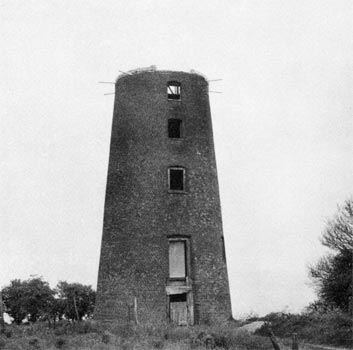 |
26th May 1970 |
HINDRINGHAM To Let from the 11 th day of October next, a capital Brick Tower WIND CORN MILL, with patent sails, driving three pairs of stones; also the Stable, Cart Shed, Double Cottage, Bakery & Outbuildings thereto appertenant & 13 Acres of good ARABLE LAND, as the same are now in the occupation of Mr. William Sands. Apply to Messrs. Wright & Woodrow, Land Agents, Queen Street, Norwich. Norfolk Chronicle - 22nd June & Norfolk News - 15th & 22nd June Lynn Advertiser - 15th June & 13th & 20th July 1867 |
GUNTHORPE, SHARINGTON & HINDRINGHAM To Let with possession next Michaelmas, A very useful FARM lying in the Parishes of Gunthorpe & Sharington comprising Farm House, Outbuildings & a capital TOWER WINDMILL turning three pairs of Stones with all the requisite Machinery & 22 acres of excellent LAND in Hindringham as now occupied by Mr. William Sands. Apply to Messrs. Wright & Woodrow, Land Agents, Queen Street, Norwich. Norfolk Chronicle & Norfolk News - 15th April 1871 |
HINDRINGHAM To Let from next Michaelmas, a capital Brick Tower WINDMILL turning three pairs of stones & having seven floors. With the mill will be let a small HOUSE & STABLE & other Outbuildings & about 13 acres of excellent Arable LAND. Apply to Messrs. Wright & Woodrow, Queen Street, Norwich. Norfolk Chronicle & Norfolk News - 6th, 13th & 20th May 1871 |
| HINDRINGHAM 7 Miles from Fakenham & 7 from the Port of Wells. To Let from Michaelmas next A capital Brick Tower WIND CORN MILL with House, stable & Outbuildings & about 22 acres of capital LAND as occupied by Mr. William Sands. Apply to Messrs. Wright & Woodrow, Queen Street, Norwich. Norfolk Chronicle & Norfolk News - 19th August & 30th September 1871 |
Situations Vacant TO MILLERS Wanted a steady industrious MAN to Work a Windmill & make himself generally useful. Good references required. R. J. Sands, Hindringham. Norfolk News - 1st August 1874 |
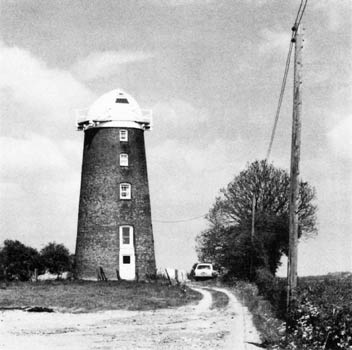 |
22nd May 1980 |
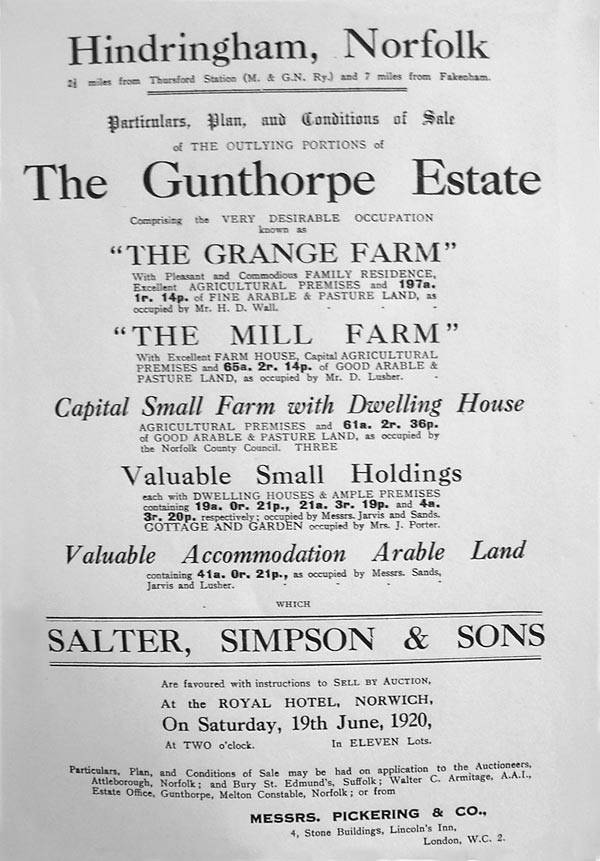 |
Part of 1920 sale brochure |
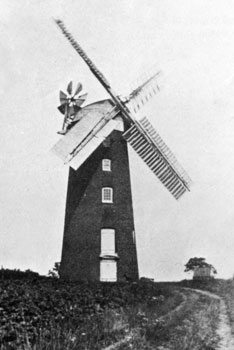 |
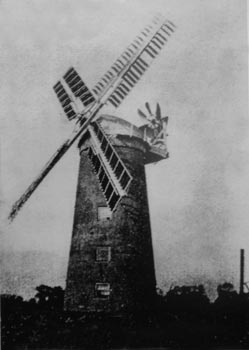 |
Lower Green mill 1902 |
Upper mill c.1903 |
I took these two photographs over 60 years ago. My uncle, Robert Wall, was the miller at the Upper_Mill when the photograph was taken about 1903; and my grandfather, Robert Wall, was at the Lower Mill in 1845, over 120 years ago. As a boy I climbed down the inside chain of the Upper_Mill from the top of the mill to the bottom and an employee climbed down the outside rope from the fly-wheel to the ground; but I dare not tackle that. S. D. Wall, Felixstowe - 1966 |
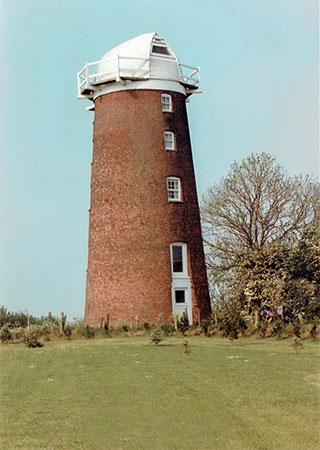 |
22nd May 1980 |
|
Lower Green Windmill
Round and round a spiral staircase. Through the lifts of brick and mortar.
Upon the crest, like clinker built. Set among the fields and flat. Like a pill the dream of owning. Sentry standing, for Centuries firm. Children running up and down.
Touch the Soul, of all who stay. Terrence Charles Pilgrim - 11th October 2006 |
In the early 1930s I used to climb and play in the mill which was owned by grandfather Harcourt Thomas David Daplyn. It was a ritual to visit the mill and the pightle each Sunday morning with my grandfather and my father Guy Daplyn as part of the routine to asess the work to be done on Church Farm during the coming week. Harcourt J. Daplyn - Skegness, 23rd March 2007 |
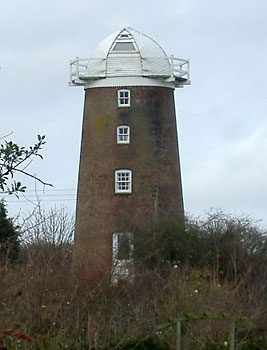 |
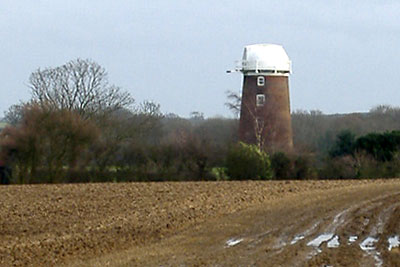 |
|
31st December 2006
|
|
Couple restore old mill using century-old fantail discovered underground |
 |
A couple who bought an old mill in Norfolk as their family holiday home have restored it using parts of its original fantail found buried underground - and now guests can stay in it too. |
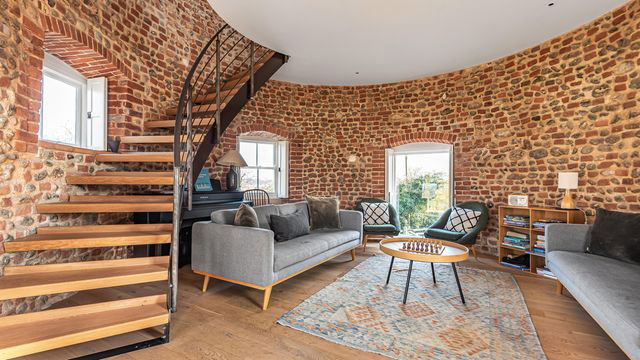 The living space in The Old Mill, which features exposed and circular brick walls The living space in The Old Mill, which features exposed and circular brick wallsand a spiral staircase leading up |
“It had been used as a holiday home for many years after being lovingly restored in the late 1960s,” Kate explains. “ Mr Forrest had renovated it himself and used it as a family holiday place. Before that, it was used as a barn - without a roof or any floors.”
|
 |
Along with the fantail they also discovered some millstones, which are now placed beside the old front door.
|
 |
O. S. Map 1885 |
Kelly's 1912: Robert John Sands, farmer |
c.1844: Mill built by William Cooke to replace a postmill on the same site at Mill Farm
1853-1856: Robert Sands, miller
1937: Mill derelict with cap framework, windshaft, brakewheel and parts of petticoat |
If you have any memories, anecdotes or photos please let us know and we may be able to use them to update the site. By all means telephone 07836 675369 or
|
| Nat
Grid Ref TF 98943750 |
Copyright © Jonathan Neville 2004 |